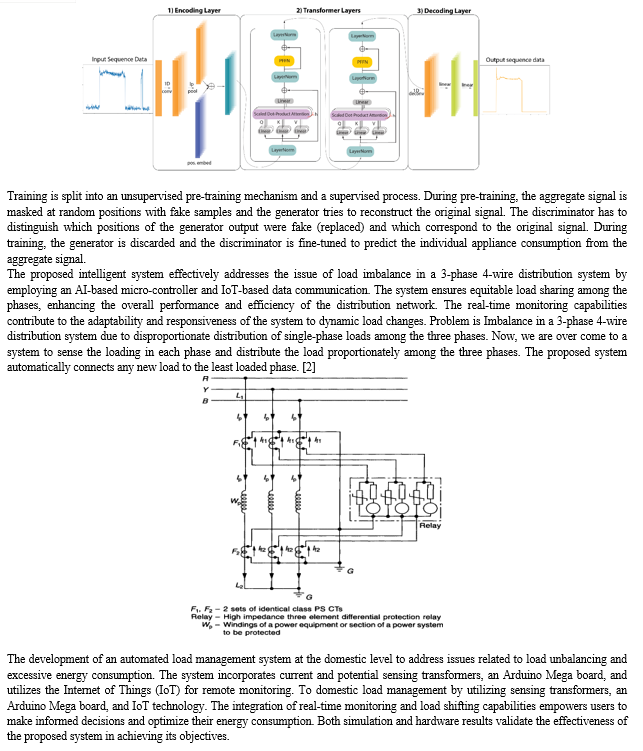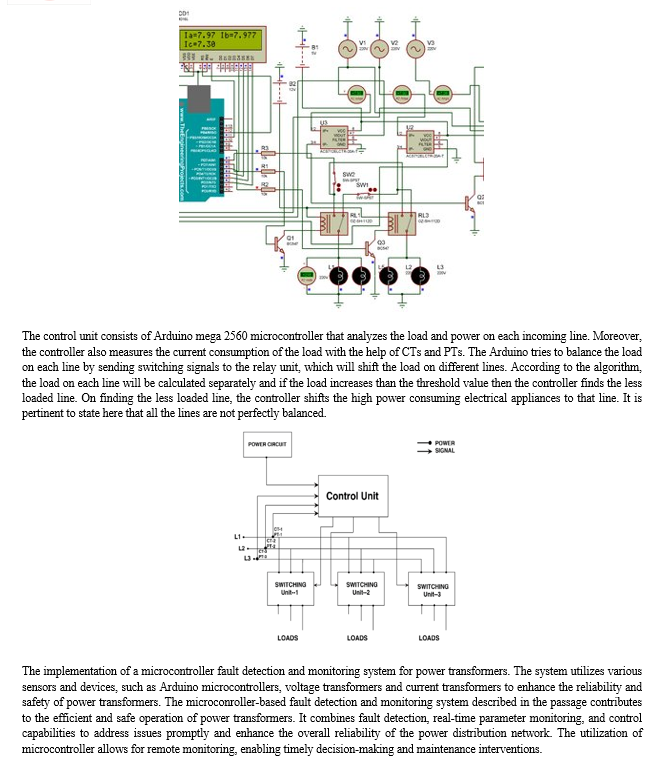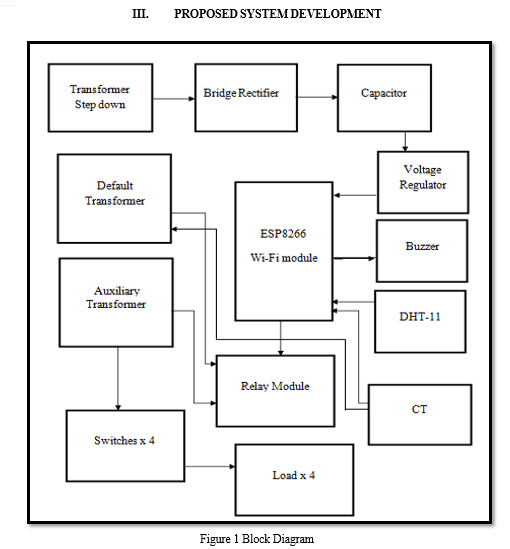Ijraset Journal For Research in Applied Science and Engineering Technology
- Home / Ijraset
- On This Page
- Abstract
- Introduction
- Conclusion
- References
- Copyright
Automatic Load Sharing of Transformer: A Comprehensive Review
Authors: Vandana Chatse , G. D. Shingade
DOI Link: https://doi.org/10.22214/ijraset.2024.63394
Certificate: View Certificate
Abstract
The demand for efficient and reliable electrical power distribution systems has grown significantly with the increasing complexity of modern electrical grids. Transformers play a crucial role in these systems, serving as key components in the transmission and distribution of electrical energy. To enhance the performance and reliability of transformer hardware, automatic load sharing mechanisms have become essential. This review paper aims to provide an in-depth analysis of the various automatic load sharing methods employed in transformer hardware to optimize energy distribution, improve system reliability, and ensure efficient load management.
Introduction
I. INTRODUCTION
Transformers is one of the most significant equipment in the electrical power system, hence transformer required protection. Apart from this the demand for electricity is increasing due to the increasing population and their unavoidable demands, with this increased power requirement, the existing systems have become overloaded. The overloading appears at the consumer end of the transformer terminals, which can affect its efficiency and protection systems. Due to overload on the transformer the efficiency drops and the windings gets over heated and may get burnt. It takes a lot of time to repair and lot of expenditure. Transformers are occasionally loaded beyond nameplate ratings because of existing possible contingencies on the transmission lines, any failure or fault in power systems, or economic considerations. One of the reported damage or tripping of the distribution transformer is due to thermal overload. To eliminate the damaging of transformers due to overloading from consumer end, it involves the control against over current tripping of distribution transformer. Rise in operating temperature of the transformer. The project is all about protecting the transformer under overload condition. by connecting another transformer in parallel through a microcontroller and a relay which shares the excess load of the first transformer. The transformers are switched alternatively to avoid thermal overloading. Therefore, two transformers work efficiently under overload condition and damage can be prevented. If there is a further increase in load beyond the capacity of two transformers there will be a priority-based load shedding of consumers which will provide un-interrupted power supply for the hospitals, industries etc. Transformers play a pivotal role in electrical distribution systems, facilitating power transmission over long distances and stepping down voltage for safe consumption. As the demand for electrical energy grows in today's technological landscape, transformers become even more essential, grappling with challenges like varying loads and disruptions. The uneven distribution of loads on transformers within modern grids poses a significant challenge. Manual load-sharing methods are inadequate for the complexities of today's grids, leading to inefficiency and equipment risks. Automatic load sharing of transformer hardware emerges as a solution, utilizing advanced technologies like microcontrollers and adaptive algorithms to optimize energy distribution, enhance reliability, and extend infrastructure lifespan. This comprehensive review delves into automatic load sharing of transformer hardware, exploring transformer types, load-sharing principles, historical limitations, and recent advances. The paper addresses challenges, cybersecurity considerations, and real-world case studies, aiming to be a valuable resource for researchers and decision-makers in the field. The significance of transformers in electrical distribution is undeniable, and the need for automatic load sharing is more critical than ever. This review provides insights into the past, present, and future of this technology, offering guidance for ensuring the reliability and efficiency of electrical power distribution systems.
II. LITERATURE SURVEY
Develop an efficient and accurate approach for NILM, which involves inferring appliance consumption patterns solely from aggregated household signals. The project introduces Electricity, a transformer-based architecture for NILM, offering superior performance, efficiency, and reduced training time compared to existing methods. The outcomes suggest that Electricity is a promising approach for accurate and efficient Non-Intrusive Load Monitoring in household energy consumption scenarios. Discuss about methodology of Utilizes sequence-to-sequence deep learning models based on transformer layers. Transformer architecture relies on attention mechanisms to extract global dependencies between aggregated and appliance signals. model Electricity to reflect its focus on electricity consumption patterns. [1]



A. Types Of Transformers
- Distribution Transformers
Distribution transformers are commonly found at the tail-end of the electrical grid, where they reduce the voltage for safe use in homes and commercial buildings. These transformers typically have lower power ratings and are often located near consumers, ensuring a consistent and reliable power supply. Commonly used in residential, commercial, and industrial areas. Multiple distribution transformers can be connected in parallel to share the load. Adjust the turns ratio to maintain a constant output voltage.
2. Power Transformers
Power transformers are situated at the heart of the electrical grid, serving as crucial elements in high-voltage transmission networks. These transformers handle substantial power capacities and are responsible for stepping up or stepping down voltage levels to facilitate long-distance power transmission. Higher voltage ratings compared to distribution transformers. Connect different parts of the power grid, such as generators, transmission lines, and distribution networks. Used for transmitting electrical power over long distances. Connect multiple power transformers in parallel to share the load. Adjust the tap settings to control the output voltage. adjust taps even during operation to accommodate load changes.
3. Special Purpose Transformers
Special purpose transformers serve specific functions in the electrical system. They can include instrument transformers, rectifier transformers, furnace transformers, and others. These transformers cater to niche requirements, and their load-sharing techniques vary based on the particular application. For instance, rectifier transformers used in industrial settings may utilize complex control algorithms to manage load sharing in response to changing manufacturing processes. Some special purpose transformers are designed to synchronize their operation with process variables, ensuring that the load-sharing mechanism aligns with specific industrial requirements.
B. Comparison Table
In this table, we explore various approaches and technologies applied to the domain of electrical systems and load management. The following table presents a comparative analysis of different studies.
|
Literature Survey Topic |
Methodology |
Key Technologies |
Conclusion |
|
Electricity: Efficient Transformer for NILM |
Non-Intrusive Load Monitoring (NILM) |
Machine Learning, Signal Processing |
Efficient NILM system using machine learning for load monitoring. High accuracy in identifying individual appliance consumption. Enables energy disaggregation without the need for intrusive sensors. |
|
Smart Load Balancing in 3-phase 4-wire System |
Dynamic Load Balancing |
3-phase 4-wire distribution system |
Effective load balancing in 3-phase 4-wire systems for optimal energy distribution. Minimizes phase imbalances and reduces losses. Utilizes real-time monitoring and control to enhance the efficiency of the distribution network. |
|
Dynamic Load Sharing at Domestic Level using IoT |
Dynamic Load Management. |
Smart Appliances, Sensors. |
Optimal load distribution in a household using controller. Utilizes real-time data from sensors and smart appliances for dynamic load management. Improves energy efficiency, reduces costs, and provides user-friendly interfaces. |
|
Load Sharing of Transformers by Arduino with GSM |
Load Sharing Control, Arduino, GSM |
Transformers, Relays, Current Transformers (CTs) |
Automation of load sharing among transformers using Arduino and GSM modules. Provides a cost-effective solution for preventing overloads and optimizing transformer utilization in power distribution systems. |
|
IoT-based Distribution Transformer Monitoring System |
Distribution Transformer Monitoring, IoT |
IoT Devices, Cloud Computing, Communication Protocols |
Real-time monitoring and protection of distribution transformers using IoT. Enhances transformer operational status monitoring, reduces downtime, and improves the overall reliability and efficiency of power distribution networks. |
Conclusion
In today\'s advanced power systems, having a dependable and effective way to distribute electrical energy is more important than ever. As our electrical grids become more complex, it\'s crucial to make sure that energy is distributed efficiently and reliably. Automatic load sharing is really important because it helps us manage energy effectively. By sharing the load among different transformers, we can make sure that the energy is distributed optimally, making the system more reliable and efficient. Researchers are exploring new and smart ways to improve our electrical systems. Integrating IoT technology, which connects devices and systems over the internet, is making our power transformers safer and more efficient. This helps in detecting faults early and ensures that our power systems work smoothly.
References
[1] S.R. Balan, P. Sivanesan, R. Ramprakash, B. Ananthakannan and K. MithinSubash,“ GSM Based Automatic Substation Load Shedding and Sharing Using Programmable Switching Control”, Journal of Selected Areas in Microelectronics, Volume 6, Issue 2, pp. 59-61. [2] Sykiotis, S, Kaselimi, M, Doulamis, A.; Doulamis, N. ELECTRIcity: An Efficient Transformer for Non-Intrusive Load Monitoring. Sensors 2022, 22, 2926. https://doi.org/10.3390/s2208292. [3] Md Atiqur Rahman and Jayanti Choudhary, “Smart load balancing system for 3-phase 4 wire distribution system”, Engineering Research Express, Eng. Res. Express 4 (2022) 045043. [4] Faizan Rashid, Raza Ahmad, Hafiz Muhammad Talha, Arslan Khalid, “Dynamic Load Sharing at Domestic Level Using the Internet of Things”, DOI: https://doi.org/10.30880/ijie.2020.12.04.006 Accepted 14 April 2020; Available online 30 April 2020 [5] Olivares-Rojas J C, Gutierrez-Gnecchi J A and Cerda-Jacobo J 2021 A transactive energy model for smart metering systems using blockchain CSEE Journal of Power and Energy Systems 7 943–53 [6] A. Gouda, A. Farag, H. Mostafa, Y. Gaber. “Smart electric grids three-phase automatic load balancing applications using genetic algorithms”, Canadian Conference on Electrical and Computer Engineering, Regina, Canda, May 5-8, 2013 [7] G. Bao, S. Ke, “Load Transfer Device for Solving a Three-Phase Unbalance Problem Under a Low-Voltage Distribution Network”, Energies, Vol. 12, No. 15, pp. 2842-2859, 2019 [8] V.M. Reddy, L.M. Saini, “Load balancing of electrical power distribution system: An overview”, International Conference on Power, Instrumentation, Control and Computing (PICC), Thrissur, India, January 18-20, 2018 [9] A. Gupta, M. Kothari, P. Kalani, P. Goyal, P. Kambar, S. Singh, “Automatic Transformer Distribution and Load Sharing Using Microcontroller”, International Journal of Electrical and Electronics Research, Vol. 4, No. 1, pp. 140-145, 2016. [10] S.R.Balan, P.Sivanesan, R.Ramprakash, B.Ananthakannan and K.MithinSubash,“ GSM Based Automatic Substation LoadShedding and Sharing Using Programmable Switching Control”, Journal of Selected Areas in Microelectronics, Volume 6, Issue 2, pp. 59-61, 2014. [11] Ashish R. Ambalkar, Nitesh M. Bhoyar, Vivek V. Badarkhe and Vivek B. Bathe, “Automatic Load Sharing of Transformers”, International Journal for Scientific Research & Development, Volume 2, Issue 12, pp. 739-741,2015. [12] Rekha.T,BinduPrakash, Asna. S, Dinesh.S and Nandana.S.Prasad, “An Intelligent Method for Load Sharing of Transformers WithTemperature Monitoring and Automatic Correction of Power Factor”, International Journal of Engineering Sciences & Research Technology, Volume 4, Issue3, pp. 416- 421, 2015. [13] Hassan Abniki, H.Afsharirad, A.Mohseni, F. Khoshkhati, Has-san Monsef, PouryaSahmsi „Effective On-line Parameters for Transformer Monitoring and Protection?, on Northern American Power Symposium (NAPS), pp 1-5, September 2010. [14] Tong Xiaoyang, Wu Guanging, Zhang Guangehun, Tan Yong-dong „A Transformer Online Monitoring and Diagnosis Em-bedded System Based on TCP/IP and Pub/Sub New Technology?, on Properties and Applications of Dielectric Materials, vol 1, pp 467-470, June2003. [15] SuxiangQian, Hongsheng Hu, „Design of Temperature Moni-toring System for Oil- Immersed Power Transformers based on MCU?, on International Conference on Electronic Measurements and Instrumentation (ICEMI), May 2009. [16] S.M Bashi, N. Mariun and A.rafa (2007). „Power Transformer protection using microcontroller based relay?, Journal of applied science, 7(12), pp.1602-1607. [17] V.Thiyagarajan & T.G. Palanivel, (J2010) „An efficient monitoring of substations using microcontroller based monitoring system? International Journal of Research and Reviews in Applied Sciences, 4 (1), pp.63-68. [18] Yarymbash D, Kotsur M, Yarymbash S, Kylymnyk I, Divchuk T. An application of scheme and field models for simulation of electromagnetic processes of power transformers. In: 2018 14th international conference on advanced trends in radioelecrtronics, telecommunications and computer engineering (TCSET). New York: IEEE; 2018. p. 308–13. [19] Paul AK, Shill PC, Rabin MRI, Murase K. Adaptive weighted fuzzy rule-based system for the risk level assessment of heart disease. Appl Intell. 2018;48(7):1739– 56. [20] Oommen T, Lindgren S. Bubble evolution from transformer overload. In: 2001 IEEE/PES transmission and distribution conference and exposition. developing new perspectives (Cat. No. 01CH37294). New York: IEEE; 2001. vol 1, p. 137-142. [21] De Carne G, Zou Z, Buticchi G, Liserre M, Vournas C. Overload control in smart transformer-fed grid. Appl Sci. 2017;7(2):208.
Copyright
Copyright © 2024 Vandana Chatse , G. D. Shingade. This is an open access article distributed under the Creative Commons Attribution License, which permits unrestricted use, distribution, and reproduction in any medium, provided the original work is properly cited.

Download Paper
Paper Id : IJRASET63394
Publish Date : 2024-06-21
ISSN : 2321-9653
Publisher Name : IJRASET
DOI Link : Click Here
 Submit Paper Online
Submit Paper Online

